Pneumatic Fittings: A Complete Buying & User Guide
Find out more about what pneumatic fittings are, how they are used and what types are available using this guide.

What are pneumatic fittings?
Pneumatic power systems include any type of mechanised/automated processes or machinery in which motion is driven by pressurised gas or compressed air. The obvious counter-reference here would be hydraulic systems, in which motion is driven by liquids held under similar compression forces within a sealed system.‘Pneumatic’ specifically denotes the delivery of power through controlled movement of pressurised gases (including air). In any pneumatic-powered system, the pressurised gases that drive the required mechanisms are typically delivered to where they’re needed through an airtight network of rigid pipes, robust hoses, and/or lengths of flexible tubing.
The vast majority of these conduits are connected to each other - as well as to the various devices being powered - by a wide variety of pneumatic fittings, couplings, valves and adaptors. As a general description, a pneumatic fitting can be any type of connector designed to link components or devices in a sealed and pressurised dry-air system.
These systems and fittings are very widely used today in all manner of industries and applications, ranging from construction, assembly and production line setups to a huge variety of industrial machinery, handheld tools and workbench equipment. In many workplace environments, the power a pneumatic system delivers can often prove more versatile, reliable, cost-effective and safer than an equivalent setup powered by various electric motors and actuators would be.
What are the different types of pneumatic fittings?
You’ll find a broad array of these fittings for sale online, covering a variety of different functions and connection types. Some common examples include:Pneumatic elbow fittings
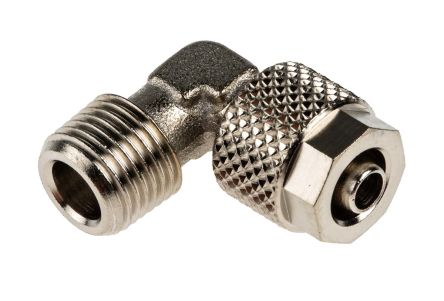
These fitings are characterised by an angled joint, commonly 90 degrees (right-angle). Pnematic elbow fittings are used to connect either single or multiple hoses and can allow the user to easily change the connections in a system for an assortment of tubes or pipes.
Key features:
- Compact and versatile
- Perfect for working with nylon tubing
Pneumatic straight fittings
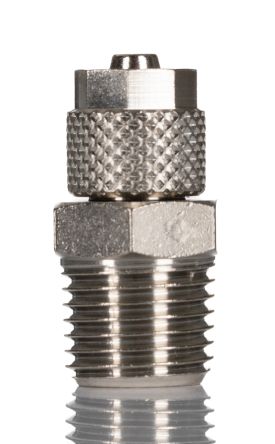
These fittings are characterised by having one threaded side and one with a tube connection, allowing for an assortment of hoses to be attached. They are often used as adaptors and are sold in a variety of diameters, thread sizes, grades and materials.
Key features:
- Fully secure
- Can be used with a wide range on instrumentation
Pneumatic T fittings
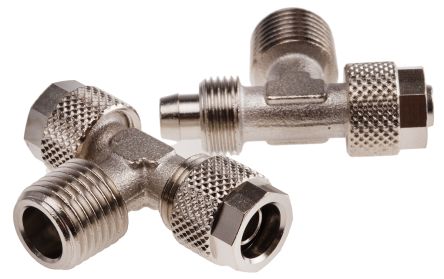
Pneumatic T fittings feature a push-in mechanism, which allow for safe and secure connections to threaded ports and supports eay and quicktool-free installing. The branch connectors and end connectors are available in either gender. These fittings are typically used in vacuum or pressure applications.
Key features:
- Full bore design
- Low leak rate
Pneumatic Y fittings
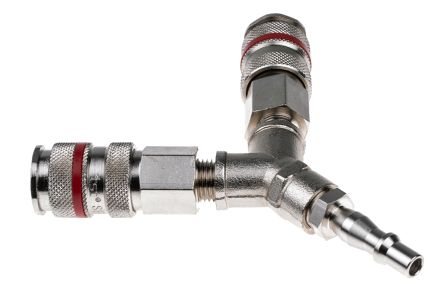
These type of fittings are ideally suited to a wide range of applications, such as: industrial air lines, air tools, garages, robotics, automotive, textile, packaging, handling applications and many more.
Key features:
- Quick connection and disconnection
- Full flow and vacuum resistant tank
- Single shut-off connectors may allow one-handed operation
Pneumatic function fittings
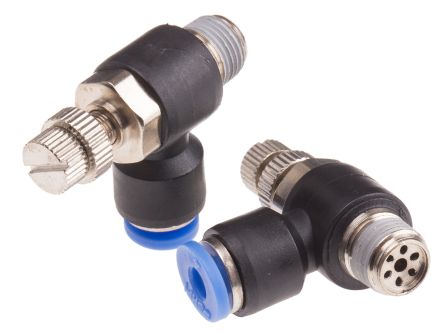
These fittings can be used in many varied roles, depending on the specific type of function performed. They are available to be purchased in many different body materials, such asaluminium alloy, brass, copper, PBT and steel alloy.
Key features:
- Can offer many functions such as blocking, exhaust, flow regulation, supply and silencing
Types of pneumatic fitting connections
When shopping for connectors and adaptors for this type of system, you’ll be presented with numerous options covering a wide variety of different assembly methods and styles. Some of the most common include:Push-in pneumatic fittings
This type is designed with speed and ease of assembly/disassembly in mind, but they’re also built to provide a secure and reliable join. They typically enable entirely tool-free connection and disconnection between various tubes, pipes and tools; ideal for fittings that will frequently need to be reassembled.The most common type of push-in fitting features a collet or ‘grab ring’ around the connection point, through which the hose or pipe slides and which then automatically grips and holds the tubing in place. Pushing down on the collet with two fingers (or a quick-release tool) instantly disconnects the fitting from the tubing.
Push-in fittings can be made from plastic or various metals, with plastics typically used for lower pressure systems; metal fittings may be required in higher-temperature applications or environments.
Tube-to-tube pneumatic fittings
Tube-to-tube adaptors are available in a variety of diameters, sizes, and materials. They’re used to connect two lengths of tubing together, either straight or at an angle, and different types can be chosen to work with a range of materials such as nylon, polyurethane or polyamide conduit.Threaded-to-tube pneumatic fittings
This type of fitting includes screw-down threading on either the inner (female) or outer (male) edge of the connector, which will be gauged to mate with matching threads on the end of a length of hose or conduit (see below for a brief section on threading sizes for pneumatic applications).Fittings sold with straight threading are intended to form a solid connection between parts, but not necessarily to form an air-tight seal on their own - this threading type will require additional sealant coating or a layer of Teflon tape for use in pneumatic applications. Fittings sold with tapered threading are intended to be airtight without the need for additional coatings or tape; this may be necessary in certain working environments where sealants and coatings may lead to corrosion or contamination.
Thread-to-barb air fittings
This is typically a type of push-on fitting in which the hose or tube is pushed over a barbed end for initial grip, and then a knurled nut is tightened down around the pipe and barb to provide full security of the connection for use under air pressure.What do pneumatic fittings attach to?
As already noted, fittings can be attached to a fairly wide range of conduit and device types - including hoses, tubing and pipe - at various points around air-powered systems. The best pneumatic fitting for your intended application and working environment will depend to a large extent by the operating pressures you need the system to be running at.However, when choosing a specific fitting type, it’s also important to be mindful of the exact sort of conduit you’re pushing the compressed air through on either side of the fitting in question. Different materials will tend to have varying properties of their own, which will often dictate the best choice of fitting to use.
Hose
‘Hose’ is typically understood to refer to a flexible type of conduit, constructed from multiple layers of robust rubberised or plastic material. It’s often designed to be replaced at fairly regular intervals due to general wear and tear. For this reason, fittings designed for use with air hose may be less permanent or more easily detached, with a view to being disassembled relatively often.
Pipe
‘Pipe’ in this context usually denotes a conduit constructed from more solid materials, often in a single layer or length, and generally seen as a better option for more permanent installations or runs. Pneumatic pipe fittings may well be more firmly fixed in place than other types, and are sometimes specifically designed for less frequent disassembly or detachment. Pipe is commonly graded or sized for fittings according to its inner diameter.
Tubing in pneumatic systems is often something of a halfway house between hose and pipe; a relatively rigid option but with some degree of flexibility and aimed at less permanent setups than most conduit pipe assemblies. Pneumatic tube is usually sized or gauged for fittings according to its outer diameter (although you should always check the manufacturer guidelines for any such product - it’s important to ensure the measurement you’re reading is the one you need for the fittings you’re using).
What pneumatic fittings brands are there?
There are several industry-leading names known worldwide for the manufacture and distribution of quality pneumatic fittings. Brands that can be found in widespread use across many industries and sectors today include:Top pneumatic fittings brands
Festo
Festo have an extensive range of fittings, such as pneumatic manifold tube-to-tube fittings, pneumatic pressure indicator function fittingsand pneumatic pressure relief valve function fittings. They have also produced a large range of pneumatic fitting accessories.

Legris
Legris have a vast selection of fittings, such as pneumatic T fittings, pneumatic manifold threaded fittings and pneumatic pressure decay sensor function fittings. To maintain your fittings quickly and efficiently to reduce production interruptions, Legris have also produced a range of pneumatic fittings maintenance kits.

Norgren
Norgren have a large array of the most common types of fittings, including elbow fittings and straight fittings. They also have a range of more specialised products, such as pneumatic logic element function fitting, and a range of accessories such as tubing sleeves for pneumatic adapters and fittings.

RS PRO
Here at RS, we have our very own pnematic fittings available to purchase. We have an array of common fittings, such as pneumatic Y fittings, as well as more specialist fittings such as pneumatic silencer and exhaust restrictor function fittings. As well as fittings, we also offer a range of additional pnematic products, including pneumatic tee tube-to-tube adaptors.
